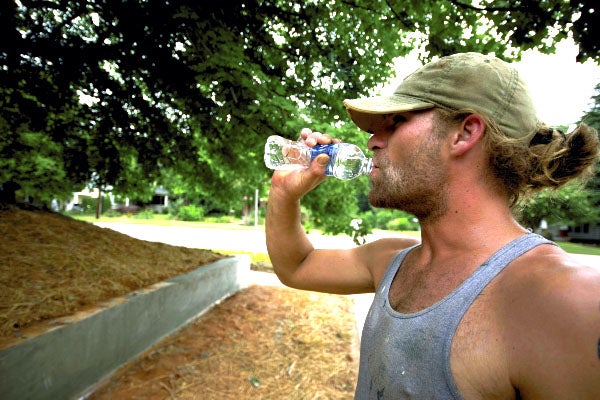Temperatures to be in upper 90s, will feel like low 100s
Published 12:10 am Friday, July 8, 2016

- JON C. LAKEY / SALISBURY POST Jon Leach takes a break from his work on a new retaining wall at a home on North Main street in Salisbury on Thursday. Leach works for Top Hat Construction and says the keeping hydrated is the most important thing about working in the heat.
By Amanda Raymond
amanda.raymond@salisburypost.com
SALISBURY — Although his gray shirt was drenched in sweat, Richard Brown, working with Top Hat Contractors to replace a roof on a house on North Main Street, said the heat doesn’t bother him.
He grew up in South Africa, so he is used to the heat. What he has a harder time handling is the humidity.
There’s no getting around it, this weekend will be a hot one.
The National Weather Service forecasts a temperature of near 96 degrees Fahrenheit in Salisbury with mostly sunny skies for Friday, but it will feel more like 102 degrees when paired with the humidity.
The air quality for Friday is predicted to be within good and moderate levels, which means it is fine to be outdoors for people without an unusual sensitivity to ozone. For those with unusual sensitivity, they should think about cutting down on outdoor exertion and watch for symptoms like coughing or shortness of breath.
Saturday is forecasted to be mostly sunny with a high close to 95 degrees and Sunday is forecasted to be mostly sunny with a high near 90 degrees.
For Central Piedmont Builders employees working at the former Benchwarmers location on Fisher Street, staying hydrated is a must.
Brick mason Chris Adcock said they try to stay out of the sun when possible.
“You try to work where the shade is,” he said.
‘Take a break when you need it,” William Dodd, laying brick next to Adcock, said.
According to the National Weather Service, heat is one of the most common causes of weather-related death in the country. Hundreds of people die and suffer from heat-related illnesses every year.
There has not been an unusual number of people going to Novant Health Rowan Medical Center for heat-related illnesses so far this year, Jessical Ijames, community engagement manager, said.
April Gaither, emergency department nurse manager, said there isn’t any specific information on the amount of people who come in for heat-related illnesses because a lot of the time doctors find the problem is an existing condition made worse by the heat.
To keep people safe during the heat, the National Weather Service advises people working on job sites to stay hydrated and take breaks in the shade often. Individuals should check in on elderly or sick neighbors, or those who do not have air conditioning.
Don’t leave children or pets inside vehicles unattended. According to a graph provided by San Jose State University, 24 children died from vehicular heatstroke in 2015 and 16 children have already died this year. In just 10 minutes, sun rays can heat the inside of a car up to 99 degrees when it is just 80 degrees outside.
The National Weather Service also advises cutting down on vigorous outdoor activities and drinking fluids and staying in the shade if doing so.
Some common heat-related illnesses to look out for are heat cramps, heat exhaustion, and heatstroke.
The National Weather Service identifies heat cramps as the first possible sign of heat-related illness that could lead to heat exhaustion or stroke.
Symptoms include painful muscle cramps and spasms in the legs and abdomen and heavy sweating. First aid tips include applying pressure on the cramping muscles or gently massaging the area to relieve the spasm. Individuals can also give the victim sips of water, but if the victim is nauseous, stop giving water.
For heat exhaustion, the symptoms include heavy sweating, weakness, cool, pale and clammy skin, fast, weak pulse, possible muscle cramps, dizziness, nausea or vomiting and fainting. To help, get the person to a cooler spot, lay him or her down and loosen his or her clothing, put cool, wet cloths on as much of his or her body as possible and offer the person sips of water. If the victim vomits more than once, then medical attention is necessary.
Heatstroke is the most serious of the heat-related illnesses. If a person is experiencing a heat stroke, call 911 or get him or her to a hospital immediately, as any delay can lead to death.
Symptoms of a heatstroke include an altered mental state, a body temperature above 103 degrees Fahrenheit, hot, red, dry or moist skin, a pulse that is fast and strong and fainting or loss of consciousness. One or more of the following symptoms could also signal a heatstroke: throbbing headache, confusion, nausea, dizziness or shallow breathing.
If waiting for an ambulance, the National Weather Service advises moving the heat stroke victim to a cooler place that is air-conditioned if possible. Try and lower the victim’s body temperature with cool cloths or a bath. Be aware that fans can make a person hotter at high temperatures, so only use one if heat index temperatures are below the high 90s. It is also important to not give fluids to a person suffering from heat stroke.
For more information, visit www.nws.noaa.gov/om/heat/heat-illness.shtml.
For those in need of assistance during the heat this summer, Kyna Grubb, executive director of Rowan Helping Ministries, said the facility is open 24 hours a day as a shelter for all types of weather.
Rowan Helping Ministries also has a crisis intervention program for those who need financial assistance with things like electricity bills.
For assistance, contact Rowan Helping Ministries to make an appointment by calling 704- 637-6838.
Contact reporter Amanda Raymond at 703-797-4222.



